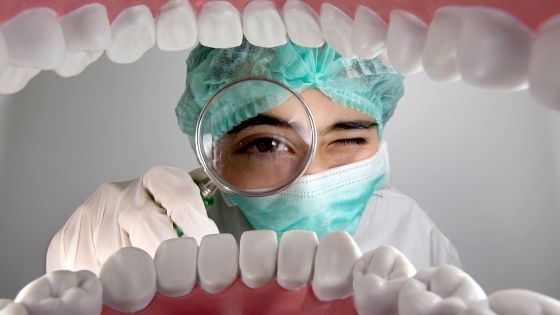Cancer is described as an uncontrolled division of cells. Generally, it occurs due to abnormal changes referred to as mutations in the DNA or genetic variations. Cancer can start anywhere in your body and spread to other parts of the body.

The oral cavity is no exception. Oral cancer arises as a primary lesion in the tissue. It may start anywhere in your oral cavity, including the salivary gland, tonsillar tissues, lymphoid tissue, or the oral mucosa cells. Based on its origin in the mouth, it can be classified as follows:
- Teratoma: which is caused by the histology of the oral tissues.
- Adenocarcinoma: which occurs from the saliva and tonsillar tissue
- Melanoma: emerges from the pigment-producing cells of the oral mucosa.
No matter what type of cancer it is, it can be treated if diagnosed early. Yet most people get a diagnosis when their condition is critical. If you are seeing a dentist or doctor regularly, you will learn how to spot suspicious changes.
Risk factors of oral cancer
A risk factor of cancer is anything that increases the chances of getting cancer. Undoubtedly, smokers and heavy drinkers have the highest risk of developing mouth cancer; there are many more causative factors. Understanding what causes it and who is more susceptible helps prevent the disease.
Tobacco and alcohol use
Tobacco and alcohol consumption is one of the most vital risk factors for oropharyngeal cancer. Most people with this cancer have a history of smoking pipes, cigars, cigarettes, and drinking alcohol. The more you are exposed to smoking tobacco or drinking alcohol, the higher your risk of developing cancer.
Human Papillomavirus (HPV)
HPV is a group of 150+ types of viruses known to cause some forms of cancers that include mouth, throat, cervix, vulva, vagina, penis, and anus cancer. Mainly, HPV 16 is a type of virus causing oropharynx cancer.
Age
Mouth cancer takes many years to develop; this is why people are older than 40 when the cancers are first diagnosed. In the biophysical or biochemical processes of aging cells, a patient’s age can show a time component allowing malignant transformation to take place, or maybe even immune system competence diminishing as one gets on in age.
Ultraviolet (UV) light
Sun’s harmful UV rays are another risk factor for cancer. Cancer of the lips is common in people in outdoor/ field jobs exposed to sunlight for more extended periods.
Diagnosis and treatment of oral cancer
Given below are the most common symptoms related to oral cancer:
- Thickenings/swellings, bumps or lumps, rough crusts/spots, or areas on the gums, lips, cheeks, or other parts in the mouth that are eroded.
- Velvety red, white, or patchy white and red speckles in the mouth
- A random feeling of numbness, sensation loss, feeling of tenderness or pain in the face, neck, or mouth region area.
- Unexplained bleeding in the mouth
- Painful or swelling in the jaw
- Dramatic weight loss
So in case, you notice any of these symptoms, it means it’s time to rush to the doctor for oral cancer pathophysiology. Your doctor will conduct an oral cancer screening exam to assess any irregular tissue growth, lumps, sores, or discolored tissue in your oral cavity during the procedure.
A biopsy may be needed to test the suspicious area of your mouth. There are different biopsies, namely, the scalpel, excisional, and incisional biopsies. Your doctor will determine which one would be the best for your depending on various factors.
Once diagnosed with cancer, you will be treated the same way the other cancer patients are treated. This means either surgery to remove the cancerous growth, followed by radiation therapy, or chemotherapy to destroy cancer cells if remaining completely.
